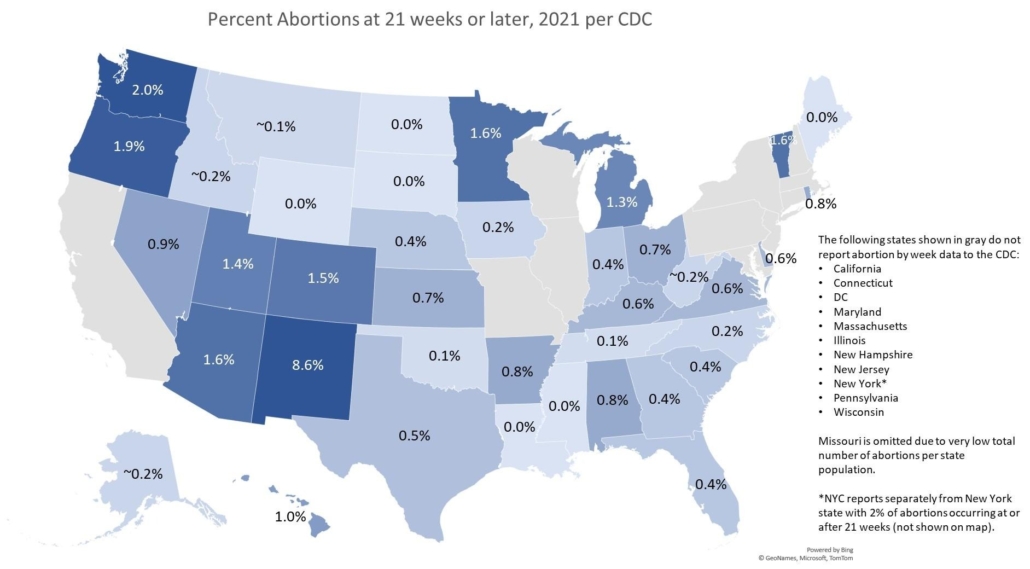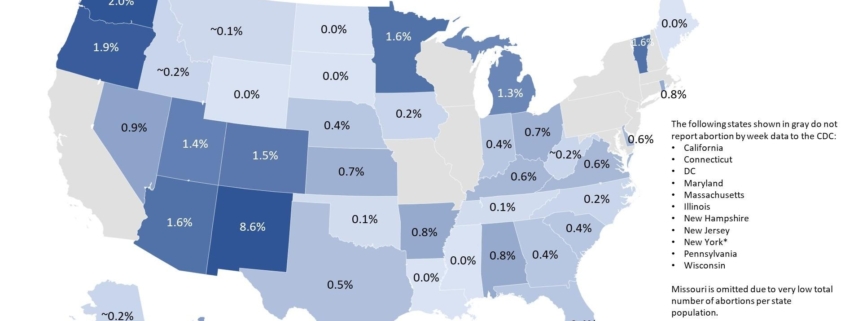Is later abortion only 1% of all abortions?
Secular Pro-Life regularly shares citations and statistics concerning later abortion, including the many reasons the topic is worth its own discussion. When we bring this up, pro-choice people will often counter with, “Later abortion is only 1% of all abortions performed.”
Of course 1% of approximately one million abortions a year is still an alarmingly large number, but it’s also not clear that the 1% stat is true in the first place.
Even some abortion advocates are questioning this statistic. On X, the abortion rights account RHAvote recently shared:
The claim that “Only 1% of abortions happen after 21wks” is a junk stat based on a misreading of CDC data. And tragically has led to a kind of stigmatizing conventional wisdom that banning later abortion isn’t that bad because it doesn’t affect that many people.
The account included this chart:

States which have legal elective abortion after 21 weeks have higher percentages of later abortions.
It’s not surprising that, compared to states with earlier gestational limits, those with later limits have higher percentages of later abortion. We see this trend for those states with later limits that report to the CDC (Table 10 here).
The percentage of abortions after 21 weeks in Colorado was 1.5%, Vermont 1.6%, Minnesota 1.9%, Oregon 1.9%, and Washington 2.0%. In New Mexico in 2021 (when the Southwestern Women’s Options clinic was still doing third trimester abortions) the percentage of abortions after 21 weeks was a massive 8.6%.

In general, states with later abortion limits have more later abortions. What does this mean for the states that don’t report abortion data to the CDC (the grayed out states above)?
The CDC 1% stat doesn’t account for about one third of the American population.
The total US population is approximately 334M. Here are the populations of the states from the above graphic:
- California: 39M
- Connecticut: 3.6M
- Washington DC: 0.7M
- Illinois: 12.5M
- Maryland: 6.2M
- Massachusetts: 7.1M
- New Hampshire: 1.4M
- New Jersey: 9.3M
- Pennsylvania: 12.8M
- New York State (excluding New York City): 11.4M
- Wisconsin: 5.9M
- TOTAL: 109.9M
So the CDC’s 1% stat regarding later abortion excludes about 33% of the US population.
The CDC 1% stat doesn’t account for many states which allow elective abortion after 21 weeks.
All of the above states allow elective abortion later in pregnancy. According to KFF their current gestational limits on elective abortion are as follows:
- California: 24 weeks/viability
- Connecticut: 24 weeks/viability
- Washington DC: no limit
- Illinois: 24 weeks/viability
- Maryland: no limit
- Massachusetts: 24 weeks/viability
- New Hampshire: 24 weeks/viability
- New Jersey: no limit
- Pennsylvania: 24 weeks/viability
- New York State: 24 weeks/viability
- Wisconsin: 22 weeks
The CDC 1% stat doesn’t account for many clinics which perform elective abortions even after 24 weeks.
These states are home to many of the abortion clinics which provide elective abortion not only after 21 weeks, but even after 24 weeks, including:
- DC: Washington-Surgi Clinic and DuPont Clinic (the location of research such as the best way to induce fetal demise at 24 weeks or later)
- Illinois: Hope Clinic and Planned Parenthood St. Louis Region
- Maryland: Partners in Abortion Care and Clinics for Abortion and Reproductive Excellence (CARE)
- Massachusetts: Women’s Health Servics
- New Jersey: Cherry Hill Women’s Center and Metropolitan Medical Associates
It’s safe to expect that in states which don’t report abortion data to the CDC, the proportion of abortions after 21 weeks is higher than 1% (though unclear by how much). It’s therefore safe to expect that if the CDC had the data on these locations, the national statistic on abortions after 21 weeks would be higher. Some pro-choicers, like RHAvote, accept this and are happy to defend even post-viability abortion as an exercise of bodily autonomy. But others may find reason to pause and consider the implications.
[Read more – Undercover at an Abortion Clinic While 28 Weeks Pregnant]
If you appreciate our work and would like to help, one of the most effective ways to do so is to become a monthly donor. You can also give a one time donation here or volunteer with us here.



